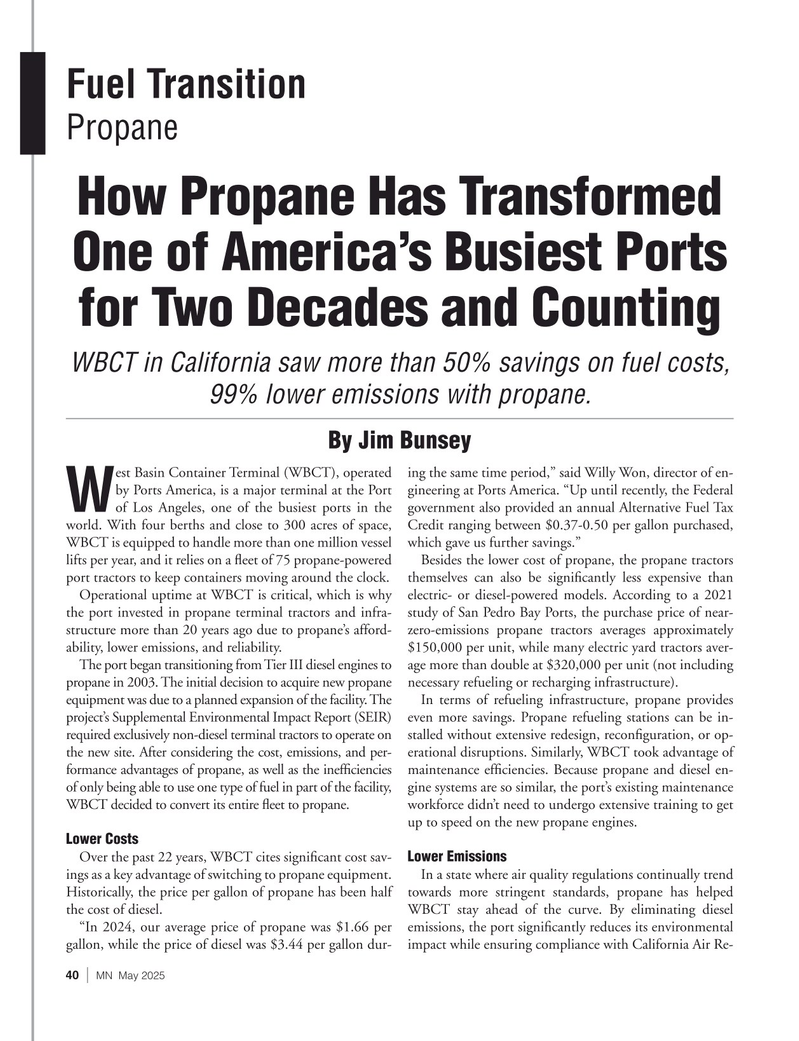
Page 40: of Marine News Magazine (May 2025)
Read this page in Pdf, Flash or Html5 edition of May 2025 Marine News Magazine
Fuel Transition
Propane
How Propane Has Transformed
One of America’s Busiest Ports for Two Decades and Counting
WBCT in California saw more than 50% savings on fuel costs, 99% lower emissions with propane.
By Jim Bunsey est Basin Container Terminal (WBCT), operated ing the same time period,” said Willy Won, director of en- by Ports America, is a major terminal at the Port gineering at Ports America. “Up until recently, the Federal
Wof Los Angeles, one of the busiest ports in the government also provided an annual Alternative Fuel Tax world. With four berths and close to 300 acres of space, Credit ranging between $0.37-0.50 per gallon purchased,
WBCT is equipped to handle more than one million vessel which gave us further savings.” lifts per year, and it relies on a ? eet of 75 propane-powered Besides the lower cost of propane, the propane tractors port tractors to keep containers moving around the clock. themselves can also be signi? cantly less expensive than
Operational uptime at WBCT is critical, which is why electric- or diesel-powered models. According to a 2021 the port invested in propane terminal tractors and infra- study of San Pedro Bay Ports, the purchase price of near- structure more than 20 years ago due to propane’s afford- zero-emissions propane tractors averages approximately ability, lower emissions, and reliability. $150,000 per unit, while many electric yard tractors aver-
The port began transitioning from Tier III diesel engines to age more than double at $320,000 per unit (not including propane in 2003. The initial decision to acquire new propane necessary refueling or recharging infrastructure).
equipment was due to a planned expansion of the facility. The In terms of refueling infrastructure, propane provides project’s Supplemental Environmental Impact Report (SEIR) even more savings. Propane refueling stations can be in- required exclusively non-diesel terminal tractors to operate on stalled without extensive redesign, recon? guration, or op- the new site. After considering the cost, emissions, and per- erational disruptions. Similarly, WBCT took advantage of formance advantages of propane, as well as the inef? ciencies maintenance ef? ciencies. Because propane and diesel en- of only being able to use one type of fuel in part of the facility, gine systems are so similar, the port’s existing maintenance
WBCT decided to convert its entire ? eet to propane. workforce didn’t need to undergo extensive training to get up to speed on the new propane engines.
Lower Costs
Over the past 22 years, WBCT cites signi? cant cost sav- Lower Emissions ings as a key advantage of switching to propane equipment. In a state where air quality regulations continually trend
Historically, the price per gallon of propane has been half towards more stringent standards, propane has helped the cost of diesel. WBCT stay ahead of the curve. By eliminating diesel “In 2024, our average price of propane was $1.66 per emissions, the port signi? cantly reduces its environmental gallon, while the price of diesel was $3.44 per gallon dur- impact while ensuring compliance with California Air Re- 40 | MN May 2025

 39
39

 41
41
